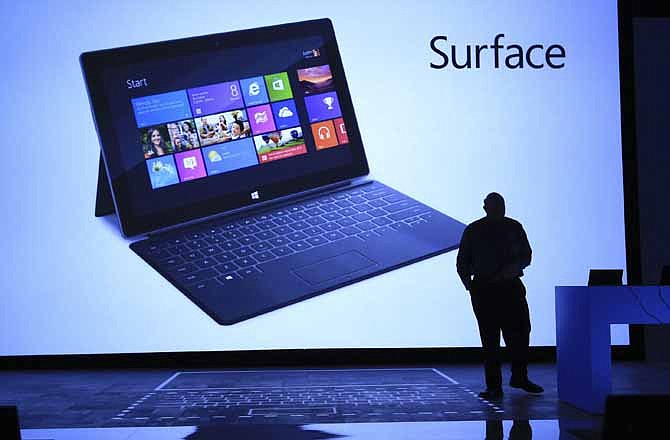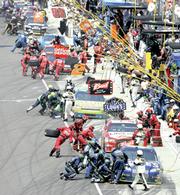LOS ANGELES (AP) - Microsoft seems to have gotten the design and form factor right with its new Surface tablet computer. But the user interface, not so much. That's an odd conclusion to make about a device from a software company that usually lets others do the manufacturing.
Still, that's how I felt after feeling the heft of the device, examining it from all sides and making a few swipes at the screen. The Surface has a touch keyboard cover that feels great and, to me, is a big step forward for tablets. The tablet's software interface, however, seems non-intuitive and sluggish.
Microsoft is clearly straddling the uncomfortable divide between the old world of mice and keyboards, where it dominates, and a future ruled by touch screens, where Apple and Android devices prevail.
Although the Surface won't go on sale until this fall, I had the chance to spend a few minutes with some devices in a group demonstration after Microsoft unveiled them in Los Angeles on Monday.
The removable cover comes across as a takeoff of Apple Inc.'s Smart Cover. Both snap into place perfectly with magnets. But instead of sporting foldable sections, Microsoft's cover is rigidly flat and has a full keyboard imprinted on it. Microsoft's cover seems central to the Surface experience, although it's not clear if it'll be sold separately. Apple sells Smart Cover separately starting at $39.
The cover is thin - about a tenth of an inch, or 3 millimeters. When covering the screen, its spine covers one edge and its outer fabric makes the whole package feel like a soft book. Where it attaches to the tablet, it's completely floppy, so it can be whipped around to close over the screen or folded back like a magazine.
The keyboard is imprinted on the inside of the cover, facing the screen. So when you open it, you can lay the cover on a table and use it to type. The letters are separated by little ridges, allowing you to feel around somewhat as you type. I have found that typing doesn't feel right on the iPad's glass.
The keyboard is covered with synthetic material that feels like a tennis racket handle or a high school running track, but not as grippy.
The keys themselves don't depress as you type. Rather, there are seven layers of metal and other material inside that sense pressure and speed. When the cover is folded open entirely, covering the back, the keys stop being sensitive to touch.
Demonstrators from Microsoft told us they could type upwards of 50 words per minute, but I didn't have access to the device long enough to test my ability to input "The quick brown fox jumped over the lazy dog."
There was another keyboard accessory with depressible keys that was 5.5 millimeters thick, or nearly twice the regular cover. It felt more comfortable for typing but didn't seem revolutionary. You can also type on the screen, the way you can on an iPad.
Running the length of the Surface is a thin, 0.7-millimeter metal flap called the kickstand. This is what transforms the device from a tablet that you can grip to a computer you can type at while sitting at a desk or table.
Microsoft made much of the fact that the sides of this thin device are cut at 22 degree angles. It's no big deal until you realize that the kickstand positions the tablet to lean back at 22 degrees, making the bottom edge flush with a flat surface.
The front-facing camera looks up at you, while the back camera is angled so that it points straight forward when the kickstand is extended. The back camera angle also should make it easier to shoot video or take pictures while looking down at the screen held at an angle.
As I said earlier, the tablet's software is what disappoints.
I detected a lag when swiping, which just seems wrong on a touch screen. After all, you can see exactly where your finger is touching. If the image doesn't come along in real time, that's noticeable. Apple's iPad and iPhone may still have Microsoft's Surface beat in this regard.
Microsoft's upcoming Windows 8 operating system and its Windows RT counterpart for low-power chips are supposed to bridge the gap between touch devices and personal computers.
But the company has made a perplexing design choice by hiding crucial navigation items off the screen. Finding them requires swiping in from the sides. I would need a tutorial on what actions lead to what results. Let's just say it is not readily apparent.
Those who have tested the software on personal computers have reported not being able to find the "Start" menu. The Surface seems to address this by putting a permanent Windows icon in the middle of the device below the screen. The icon causes a vibration when touched, which helps because it's not a physical button.
Who would use this device?
At the announcement on Monday, CEO Steve Ballmer pounded home the message that this tablet will be as good as a PC for creating documents in a way that the iPad never was. It's true that the iPad has such shortcomings as an inability to run multiple programs side by side, the way you can on a regular computer. Surface can run at least two at a time.
So, users would seem to be professionals who want a tablet they can use for work and play.
I find that proposition appealing, especially after lugging my heavy laptop to the press conference and having to keep a watchful eye on the dwindling battery life. (Speaking of which, Microsoft still hasn't said anything about the Surface's expected battery life.)
Microsoft said the low-power version using Nvidia chips will cost about the same as other tablets, while a version that runs Windows 8 Pro will cost about the same as other ultrabooks with Intel processors. The Pro version will have a stylus that allows users to make handwritten notes on documents such as PDF files. It also has an Intel processor and the option for more memory.
Surface splits the difference between a standard tablet and super-light laptops such as Apple's MacBook Air or ultrabooks that run Windows. But typing on the Surface's keyboard cover seems to require just that, a surface. I'm not sure how I would manage the cover keyboard and a kickstand on my lap.
Microsoft's ultimate challenge seems to be making sure that all the programs on my current laptop - including its range of Office software - can run smoothly on Surface. It's not clear yet whether it can deliver on that vision.


